Accounting Report: Analysis of Intangible Assets and Recommendations
VerifiedAdded on 2020/06/06
|7
|1679
|64
Report
AI Summary
This accounting report delves into the complexities of intangible assets, focusing on their identification, valuation, and treatment according to accounting standards. The report analyzes a case study involving Snow Protek, examining the correct accounting for a purchased brand, research and development costs, and the application of impairment tests. It highlights discrepancies in the company's current accounting practices, such as the incorrect valuation of the brand and the capitalization of certain expenses. The report provides specific recommendations for correcting these errors, including adjusting entries for the brand's initial recognition, reclassifying marketing and research expenses, and correctly accounting for abandoned projects. The analysis also covers the carrying amount of intangible assets. The report emphasizes the importance of adhering to AASB standards to ensure accurate financial reporting, providing a clear understanding of how intangible assets should be managed and reflected in financial statements.
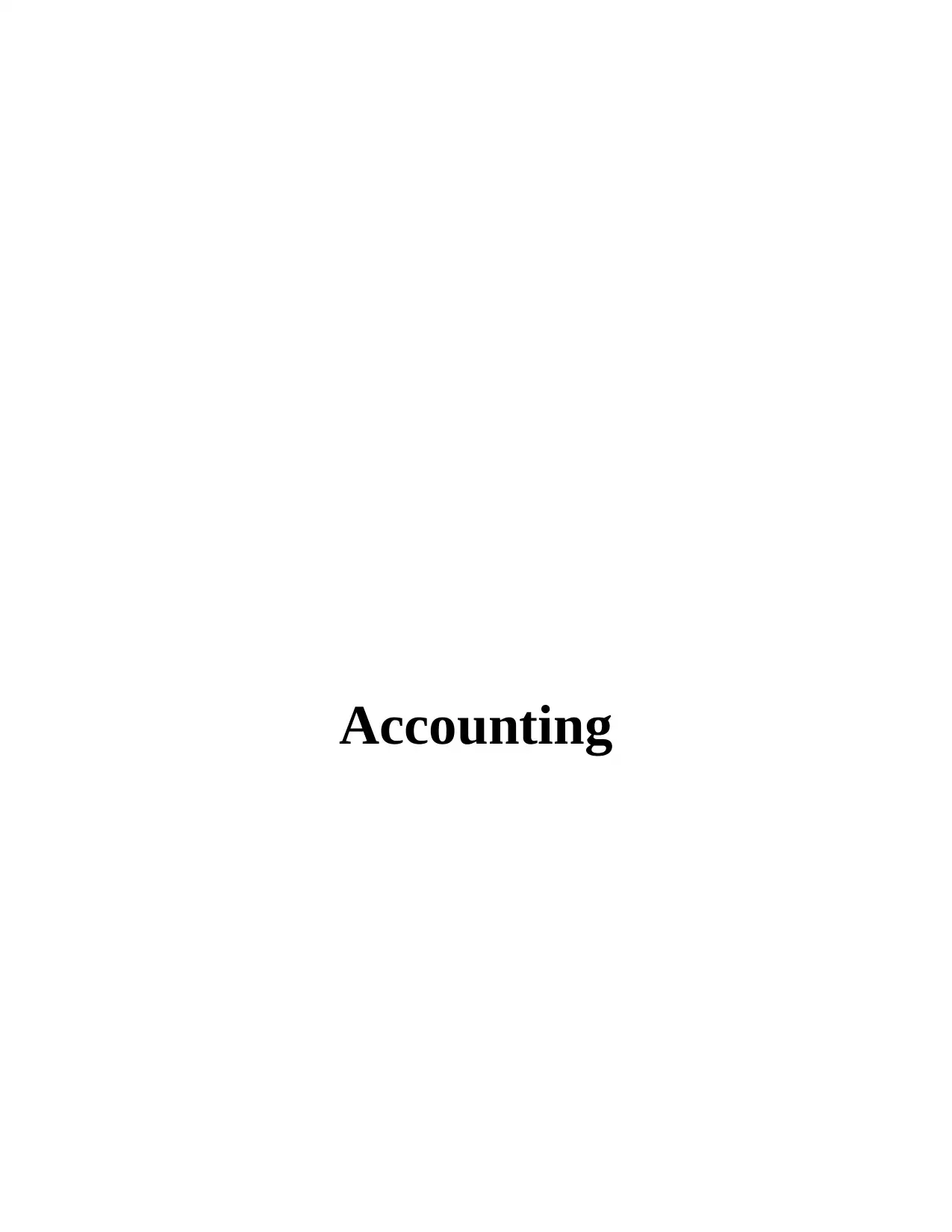
Accounting
Paraphrase This Document
Need a fresh take? Get an instant paraphrase of this document with our AI Paraphraser
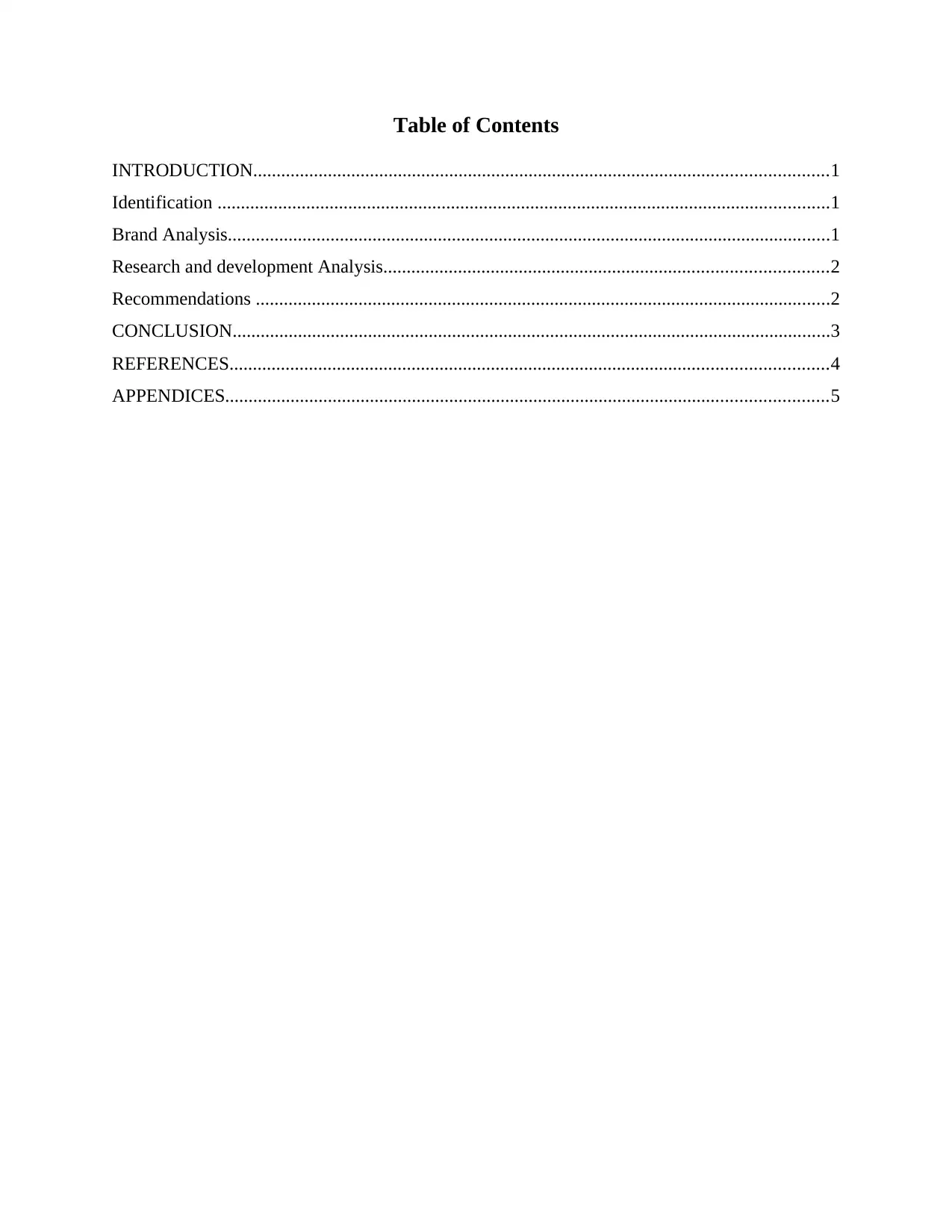
Table of Contents
INTRODUCTION...........................................................................................................................1
Identification ...................................................................................................................................1
Brand Analysis.................................................................................................................................1
Research and development Analysis...............................................................................................2
Recommendations ...........................................................................................................................2
CONCLUSION................................................................................................................................3
REFERENCES................................................................................................................................4
APPENDICES.................................................................................................................................5
INTRODUCTION...........................................................................................................................1
Identification ...................................................................................................................................1
Brand Analysis.................................................................................................................................1
Research and development Analysis...............................................................................................2
Recommendations ...........................................................................................................................2
CONCLUSION................................................................................................................................3
REFERENCES................................................................................................................................4
APPENDICES.................................................................................................................................5
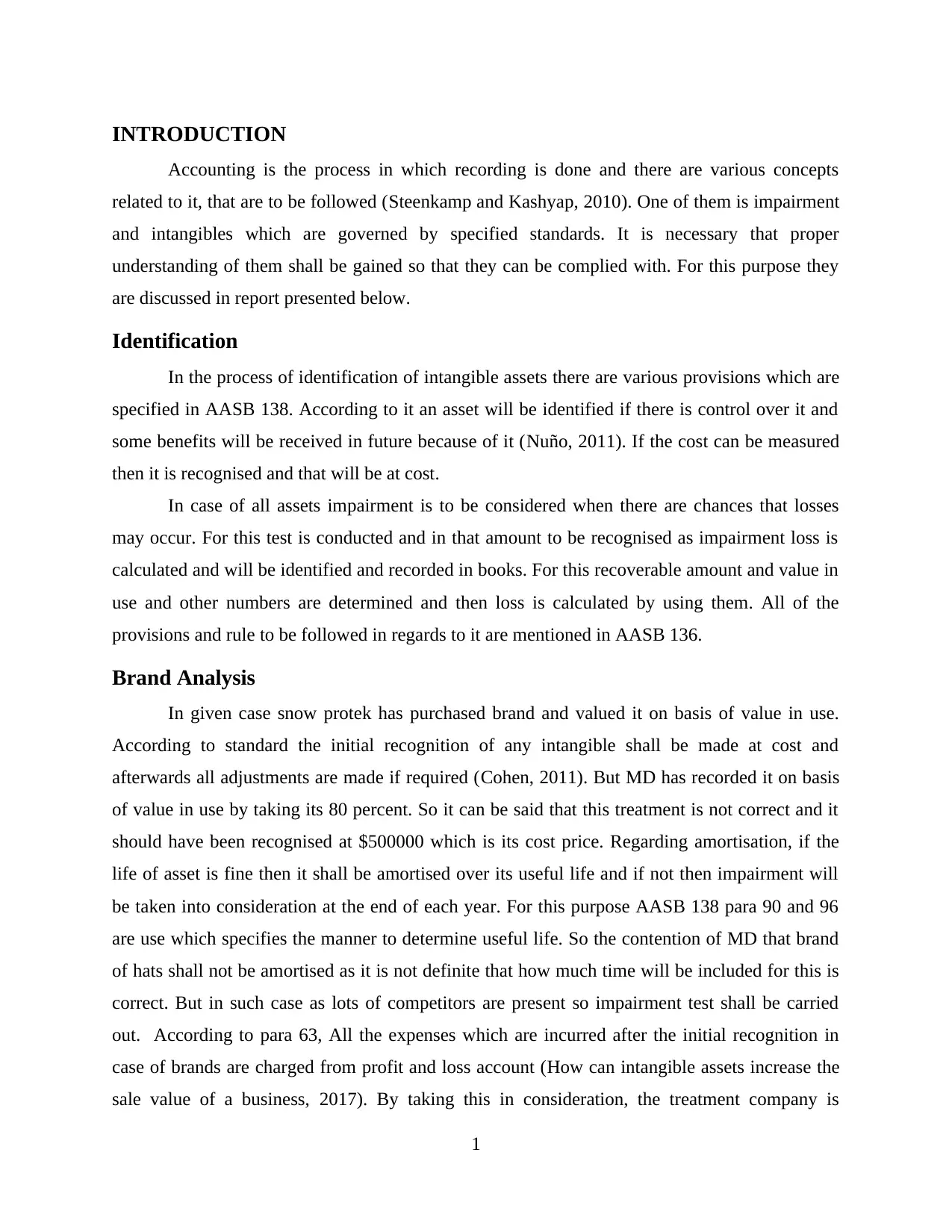
INTRODUCTION
Accounting is the process in which recording is done and there are various concepts
related to it, that are to be followed (Steenkamp and Kashyap, 2010). One of them is impairment
and intangibles which are governed by specified standards. It is necessary that proper
understanding of them shall be gained so that they can be complied with. For this purpose they
are discussed in report presented below.
Identification
In the process of identification of intangible assets there are various provisions which are
specified in AASB 138. According to it an asset will be identified if there is control over it and
some benefits will be received in future because of it (Nuño, 2011). If the cost can be measured
then it is recognised and that will be at cost.
In case of all assets impairment is to be considered when there are chances that losses
may occur. For this test is conducted and in that amount to be recognised as impairment loss is
calculated and will be identified and recorded in books. For this recoverable amount and value in
use and other numbers are determined and then loss is calculated by using them. All of the
provisions and rule to be followed in regards to it are mentioned in AASB 136.
Brand Analysis
In given case snow protek has purchased brand and valued it on basis of value in use.
According to standard the initial recognition of any intangible shall be made at cost and
afterwards all adjustments are made if required (Cohen, 2011). But MD has recorded it on basis
of value in use by taking its 80 percent. So it can be said that this treatment is not correct and it
should have been recognised at $500000 which is its cost price. Regarding amortisation, if the
life of asset is fine then it shall be amortised over its useful life and if not then impairment will
be taken into consideration at the end of each year. For this purpose AASB 138 para 90 and 96
are use which specifies the manner to determine useful life. So the contention of MD that brand
of hats shall not be amortised as it is not definite that how much time will be included for this is
correct. But in such case as lots of competitors are present so impairment test shall be carried
out. According to para 63, All the expenses which are incurred after the initial recognition in
case of brands are charged from profit and loss account (How can intangible assets increase the
sale value of a business, 2017). By taking this in consideration, the treatment company is
1
Accounting is the process in which recording is done and there are various concepts
related to it, that are to be followed (Steenkamp and Kashyap, 2010). One of them is impairment
and intangibles which are governed by specified standards. It is necessary that proper
understanding of them shall be gained so that they can be complied with. For this purpose they
are discussed in report presented below.
Identification
In the process of identification of intangible assets there are various provisions which are
specified in AASB 138. According to it an asset will be identified if there is control over it and
some benefits will be received in future because of it (Nuño, 2011). If the cost can be measured
then it is recognised and that will be at cost.
In case of all assets impairment is to be considered when there are chances that losses
may occur. For this test is conducted and in that amount to be recognised as impairment loss is
calculated and will be identified and recorded in books. For this recoverable amount and value in
use and other numbers are determined and then loss is calculated by using them. All of the
provisions and rule to be followed in regards to it are mentioned in AASB 136.
Brand Analysis
In given case snow protek has purchased brand and valued it on basis of value in use.
According to standard the initial recognition of any intangible shall be made at cost and
afterwards all adjustments are made if required (Cohen, 2011). But MD has recorded it on basis
of value in use by taking its 80 percent. So it can be said that this treatment is not correct and it
should have been recognised at $500000 which is its cost price. Regarding amortisation, if the
life of asset is fine then it shall be amortised over its useful life and if not then impairment will
be taken into consideration at the end of each year. For this purpose AASB 138 para 90 and 96
are use which specifies the manner to determine useful life. So the contention of MD that brand
of hats shall not be amortised as it is not definite that how much time will be included for this is
correct. But in such case as lots of competitors are present so impairment test shall be carried
out. According to para 63, All the expenses which are incurred after the initial recognition in
case of brands are charged from profit and loss account (How can intangible assets increase the
sale value of a business, 2017). By taking this in consideration, the treatment company is
1
⊘ This is a preview!⊘
Do you want full access?
Subscribe today to unlock all pages.

Trusted by 1+ million students worldwide
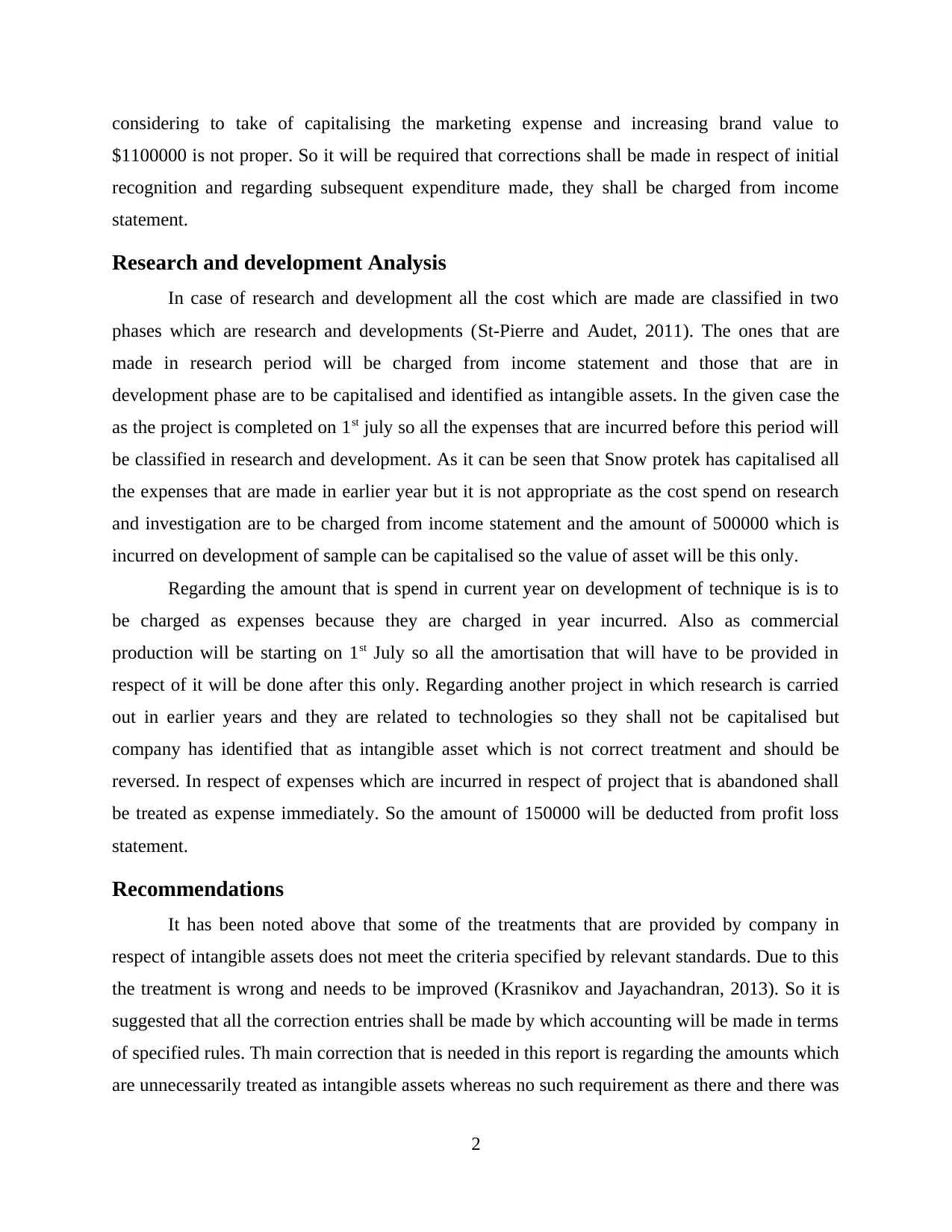
considering to take of capitalising the marketing expense and increasing brand value to
$1100000 is not proper. So it will be required that corrections shall be made in respect of initial
recognition and regarding subsequent expenditure made, they shall be charged from income
statement.
Research and development Analysis
In case of research and development all the cost which are made are classified in two
phases which are research and developments (St-Pierre and Audet, 2011). The ones that are
made in research period will be charged from income statement and those that are in
development phase are to be capitalised and identified as intangible assets. In the given case the
as the project is completed on 1st july so all the expenses that are incurred before this period will
be classified in research and development. As it can be seen that Snow protek has capitalised all
the expenses that are made in earlier year but it is not appropriate as the cost spend on research
and investigation are to be charged from income statement and the amount of 500000 which is
incurred on development of sample can be capitalised so the value of asset will be this only.
Regarding the amount that is spend in current year on development of technique is is to
be charged as expenses because they are charged in year incurred. Also as commercial
production will be starting on 1st July so all the amortisation that will have to be provided in
respect of it will be done after this only. Regarding another project in which research is carried
out in earlier years and they are related to technologies so they shall not be capitalised but
company has identified that as intangible asset which is not correct treatment and should be
reversed. In respect of expenses which are incurred in respect of project that is abandoned shall
be treated as expense immediately. So the amount of 150000 will be deducted from profit loss
statement.
Recommendations
It has been noted above that some of the treatments that are provided by company in
respect of intangible assets does not meet the criteria specified by relevant standards. Due to this
the treatment is wrong and needs to be improved (Krasnikov and Jayachandran, 2013). So it is
suggested that all the correction entries shall be made by which accounting will be made in terms
of specified rules. Th main correction that is needed in this report is regarding the amounts which
are unnecessarily treated as intangible assets whereas no such requirement as there and there was
2
$1100000 is not proper. So it will be required that corrections shall be made in respect of initial
recognition and regarding subsequent expenditure made, they shall be charged from income
statement.
Research and development Analysis
In case of research and development all the cost which are made are classified in two
phases which are research and developments (St-Pierre and Audet, 2011). The ones that are
made in research period will be charged from income statement and those that are in
development phase are to be capitalised and identified as intangible assets. In the given case the
as the project is completed on 1st july so all the expenses that are incurred before this period will
be classified in research and development. As it can be seen that Snow protek has capitalised all
the expenses that are made in earlier year but it is not appropriate as the cost spend on research
and investigation are to be charged from income statement and the amount of 500000 which is
incurred on development of sample can be capitalised so the value of asset will be this only.
Regarding the amount that is spend in current year on development of technique is is to
be charged as expenses because they are charged in year incurred. Also as commercial
production will be starting on 1st July so all the amortisation that will have to be provided in
respect of it will be done after this only. Regarding another project in which research is carried
out in earlier years and they are related to technologies so they shall not be capitalised but
company has identified that as intangible asset which is not correct treatment and should be
reversed. In respect of expenses which are incurred in respect of project that is abandoned shall
be treated as expense immediately. So the amount of 150000 will be deducted from profit loss
statement.
Recommendations
It has been noted above that some of the treatments that are provided by company in
respect of intangible assets does not meet the criteria specified by relevant standards. Due to this
the treatment is wrong and needs to be improved (Krasnikov and Jayachandran, 2013). So it is
suggested that all the correction entries shall be made by which accounting will be made in terms
of specified rules. Th main correction that is needed in this report is regarding the amounts which
are unnecessarily treated as intangible assets whereas no such requirement as there and there was
2
Paraphrase This Document
Need a fresh take? Get an instant paraphrase of this document with our AI Paraphraser
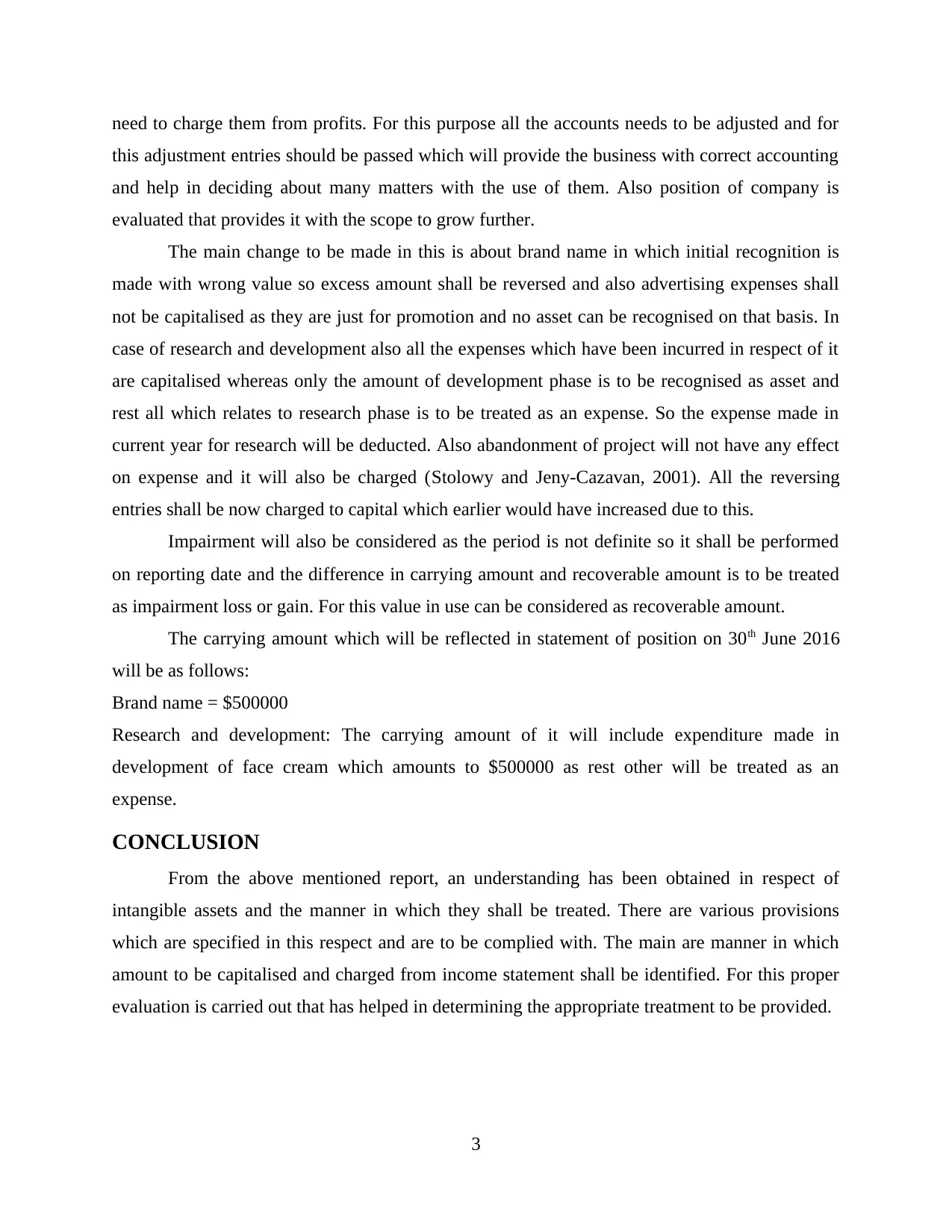
need to charge them from profits. For this purpose all the accounts needs to be adjusted and for
this adjustment entries should be passed which will provide the business with correct accounting
and help in deciding about many matters with the use of them. Also position of company is
evaluated that provides it with the scope to grow further.
The main change to be made in this is about brand name in which initial recognition is
made with wrong value so excess amount shall be reversed and also advertising expenses shall
not be capitalised as they are just for promotion and no asset can be recognised on that basis. In
case of research and development also all the expenses which have been incurred in respect of it
are capitalised whereas only the amount of development phase is to be recognised as asset and
rest all which relates to research phase is to be treated as an expense. So the expense made in
current year for research will be deducted. Also abandonment of project will not have any effect
on expense and it will also be charged (Stolowy and Jeny-Cazavan, 2001). All the reversing
entries shall be now charged to capital which earlier would have increased due to this.
Impairment will also be considered as the period is not definite so it shall be performed
on reporting date and the difference in carrying amount and recoverable amount is to be treated
as impairment loss or gain. For this value in use can be considered as recoverable amount.
The carrying amount which will be reflected in statement of position on 30th June 2016
will be as follows:
Brand name = $500000
Research and development: The carrying amount of it will include expenditure made in
development of face cream which amounts to $500000 as rest other will be treated as an
expense.
CONCLUSION
From the above mentioned report, an understanding has been obtained in respect of
intangible assets and the manner in which they shall be treated. There are various provisions
which are specified in this respect and are to be complied with. The main are manner in which
amount to be capitalised and charged from income statement shall be identified. For this proper
evaluation is carried out that has helped in determining the appropriate treatment to be provided.
3
this adjustment entries should be passed which will provide the business with correct accounting
and help in deciding about many matters with the use of them. Also position of company is
evaluated that provides it with the scope to grow further.
The main change to be made in this is about brand name in which initial recognition is
made with wrong value so excess amount shall be reversed and also advertising expenses shall
not be capitalised as they are just for promotion and no asset can be recognised on that basis. In
case of research and development also all the expenses which have been incurred in respect of it
are capitalised whereas only the amount of development phase is to be recognised as asset and
rest all which relates to research phase is to be treated as an expense. So the expense made in
current year for research will be deducted. Also abandonment of project will not have any effect
on expense and it will also be charged (Stolowy and Jeny-Cazavan, 2001). All the reversing
entries shall be now charged to capital which earlier would have increased due to this.
Impairment will also be considered as the period is not definite so it shall be performed
on reporting date and the difference in carrying amount and recoverable amount is to be treated
as impairment loss or gain. For this value in use can be considered as recoverable amount.
The carrying amount which will be reflected in statement of position on 30th June 2016
will be as follows:
Brand name = $500000
Research and development: The carrying amount of it will include expenditure made in
development of face cream which amounts to $500000 as rest other will be treated as an
expense.
CONCLUSION
From the above mentioned report, an understanding has been obtained in respect of
intangible assets and the manner in which they shall be treated. There are various provisions
which are specified in this respect and are to be complied with. The main are manner in which
amount to be capitalised and charged from income statement shall be identified. For this proper
evaluation is carried out that has helped in determining the appropriate treatment to be provided.
3
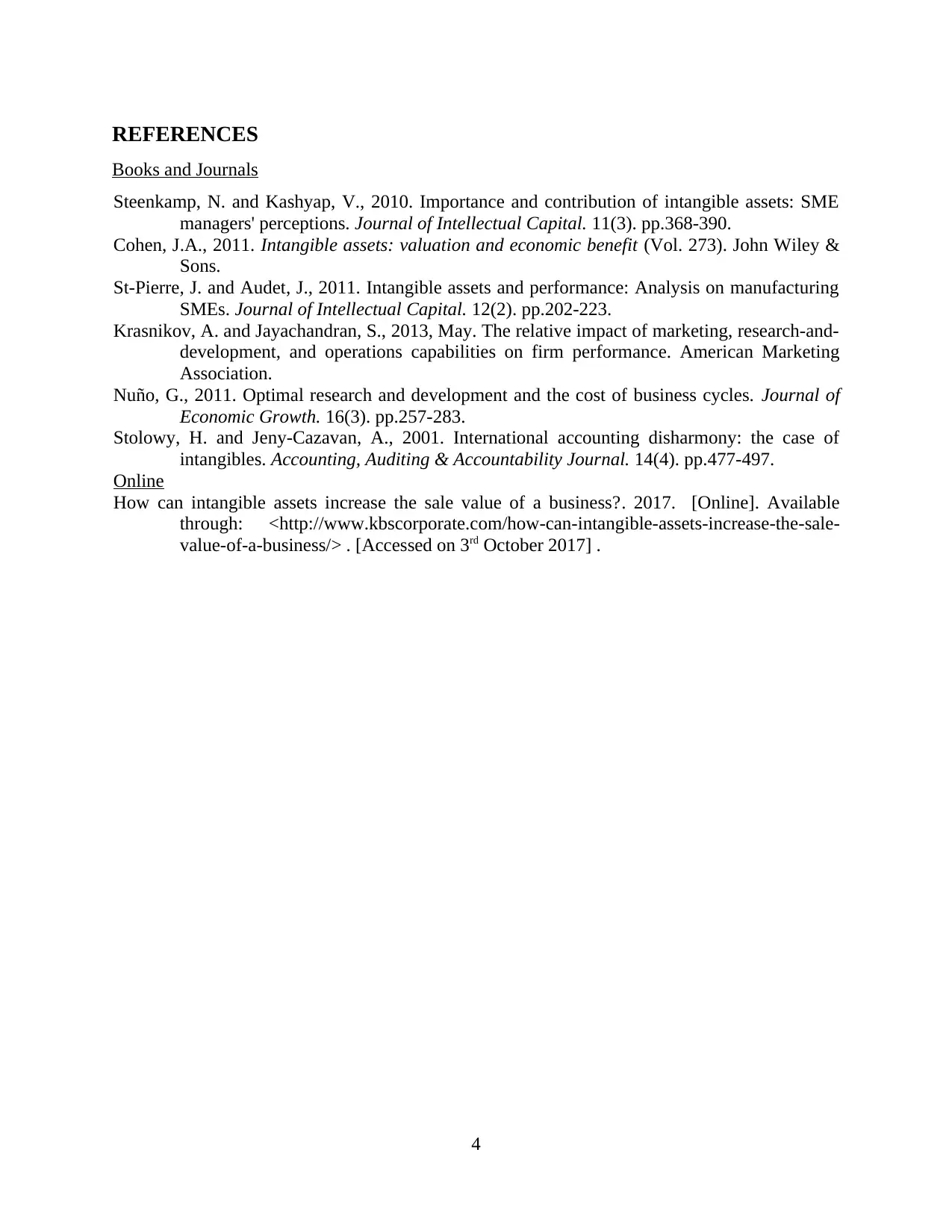
REFERENCES
Books and Journals
Steenkamp, N. and Kashyap, V., 2010. Importance and contribution of intangible assets: SME
managers' perceptions. Journal of Intellectual Capital. 11(3). pp.368-390.
Cohen, J.A., 2011. Intangible assets: valuation and economic benefit (Vol. 273). John Wiley &
Sons.
St-Pierre, J. and Audet, J., 2011. Intangible assets and performance: Analysis on manufacturing
SMEs. Journal of Intellectual Capital. 12(2). pp.202-223.
Krasnikov, A. and Jayachandran, S., 2013, May. The relative impact of marketing, research-and-
development, and operations capabilities on firm performance. American Marketing
Association.
Nuño, G., 2011. Optimal research and development and the cost of business cycles. Journal of
Economic Growth. 16(3). pp.257-283.
Stolowy, H. and Jeny-Cazavan, A., 2001. International accounting disharmony: the case of
intangibles. Accounting, Auditing & Accountability Journal. 14(4). pp.477-497.
Online
How can intangible assets increase the sale value of a business?. 2017. [Online]. Available
through: <http://www.kbscorporate.com/how-can-intangible-assets-increase-the-sale-
value-of-a-business/> . [Accessed on 3rd October 2017] .
4
Books and Journals
Steenkamp, N. and Kashyap, V., 2010. Importance and contribution of intangible assets: SME
managers' perceptions. Journal of Intellectual Capital. 11(3). pp.368-390.
Cohen, J.A., 2011. Intangible assets: valuation and economic benefit (Vol. 273). John Wiley &
Sons.
St-Pierre, J. and Audet, J., 2011. Intangible assets and performance: Analysis on manufacturing
SMEs. Journal of Intellectual Capital. 12(2). pp.202-223.
Krasnikov, A. and Jayachandran, S., 2013, May. The relative impact of marketing, research-and-
development, and operations capabilities on firm performance. American Marketing
Association.
Nuño, G., 2011. Optimal research and development and the cost of business cycles. Journal of
Economic Growth. 16(3). pp.257-283.
Stolowy, H. and Jeny-Cazavan, A., 2001. International accounting disharmony: the case of
intangibles. Accounting, Auditing & Accountability Journal. 14(4). pp.477-497.
Online
How can intangible assets increase the sale value of a business?. 2017. [Online]. Available
through: <http://www.kbscorporate.com/how-can-intangible-assets-increase-the-sale-
value-of-a-business/> . [Accessed on 3rd October 2017] .
4
⊘ This is a preview!⊘
Do you want full access?
Subscribe today to unlock all pages.

Trusted by 1+ million students worldwide
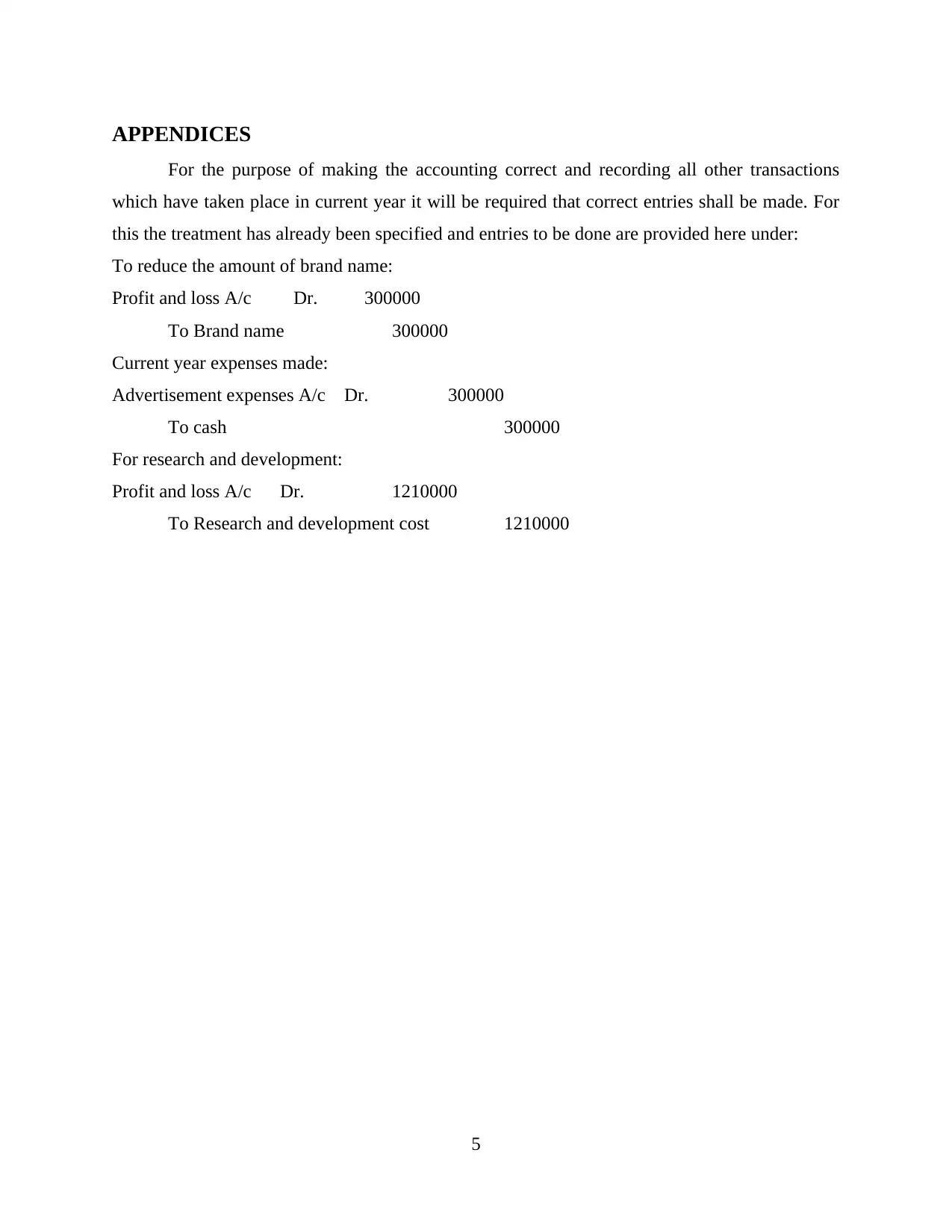
APPENDICES
For the purpose of making the accounting correct and recording all other transactions
which have taken place in current year it will be required that correct entries shall be made. For
this the treatment has already been specified and entries to be done are provided here under:
To reduce the amount of brand name:
Profit and loss A/c Dr. 300000
To Brand name 300000
Current year expenses made:
Advertisement expenses A/c Dr. 300000
To cash 300000
For research and development:
Profit and loss A/c Dr. 1210000
To Research and development cost 1210000
5
For the purpose of making the accounting correct and recording all other transactions
which have taken place in current year it will be required that correct entries shall be made. For
this the treatment has already been specified and entries to be done are provided here under:
To reduce the amount of brand name:
Profit and loss A/c Dr. 300000
To Brand name 300000
Current year expenses made:
Advertisement expenses A/c Dr. 300000
To cash 300000
For research and development:
Profit and loss A/c Dr. 1210000
To Research and development cost 1210000
5
1 out of 7
Related Documents
Your All-in-One AI-Powered Toolkit for Academic Success.
+13062052269
info@desklib.com
Available 24*7 on WhatsApp / Email
![[object Object]](/_next/static/media/star-bottom.7253800d.svg)
Unlock your academic potential
Copyright © 2020–2025 A2Z Services. All Rights Reserved. Developed and managed by ZUCOL.





